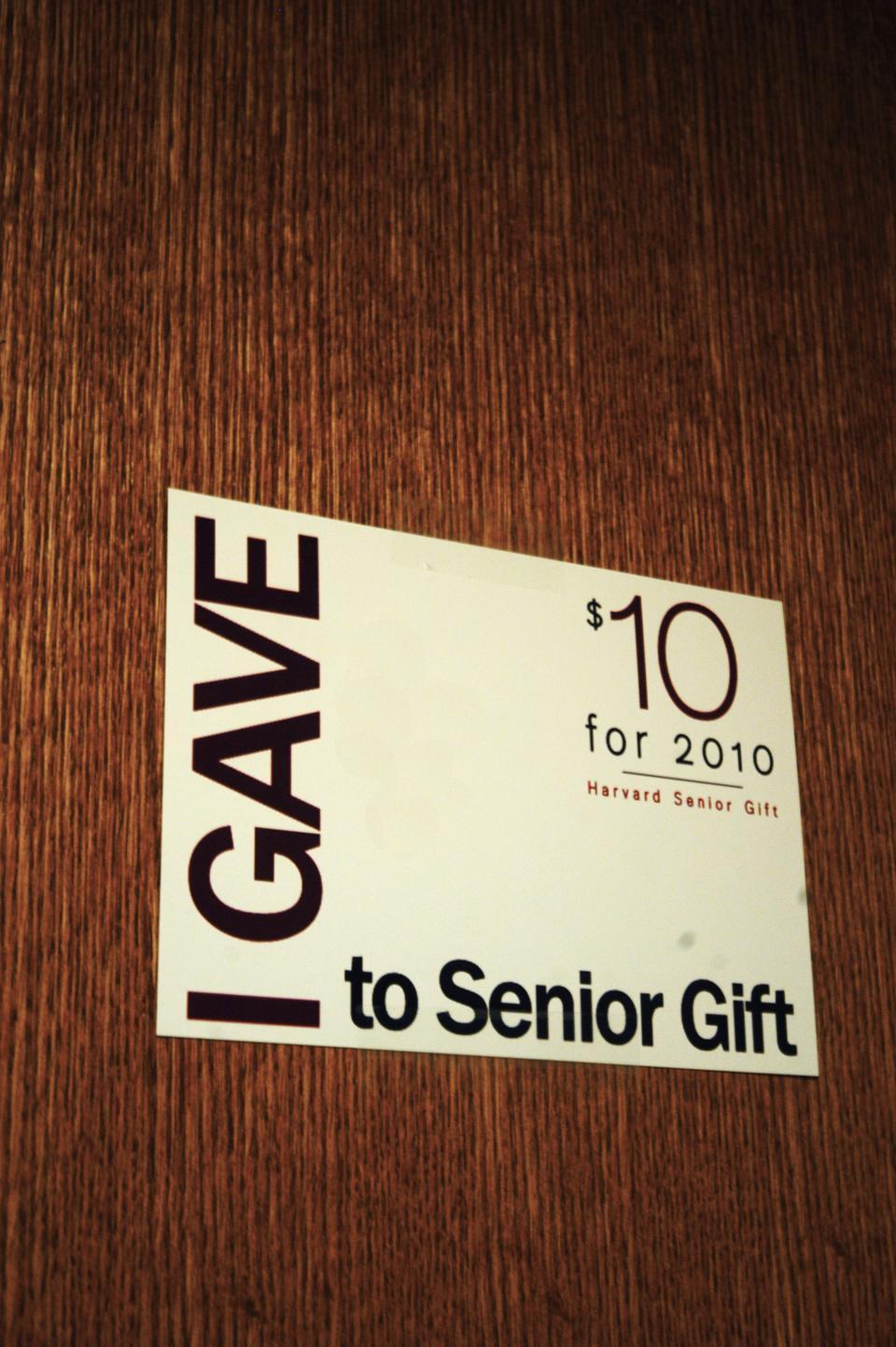
Unwrapping the Senior Gift
According to the Harvard College Fund Web site, “Senior Gift is about coming together as a class and giving back to our college.” With its “$10 for 2010” campaign, the Senior Gift Committee is aiming for every graduating senior to donate at least $10, especially after the Class of 2009 broke previous records with a 74.1 percent participation rate. Students can choose to give to financial aid, the Dean’s Fund for Undergraduate Experience, or a pool of unrestricted funds to be used where money is needed most this year. Past senior gift donations have helped fund new projects, including the Queen’s Head Pub and the Women’s Leadership Conference. But perhaps more important than the immediate benefits to the College is the introduction that Senior Gift provides into the world of alumni giving.
To that end, the Committee, which is led by co-chairs Alterrell M.F. Mills ’10, Diana C. Robles ’10, and Mary K.B. Cox ’10, also oversees a special Associates Committee dedicated to soliciting donations of $250 or more; these gifts are then labeled “Associates-level.” With this special committee, the Senior Gift campaign attempts to succeed as both a symbol of class camaraderie and as a fundraising effort.
“Our big goal is participation while still acknowledging that there are students on campus who can make that Associates-level gift,” Cox says.
DEBUNKING THE ASSOCIATE’S COMMITTEE
Within a Senior Gift Committee of more than 150 people, there are 5 Associates Chairs and 21 Associates Committee members who are charged with the task of asking their peers for relatively large sums of money. The job has two important requirements.
“It’s a sensitive topic,” Mills said. “We look for people who are able to approach it in a sensitive way.” Additionally, the Chairs and Committee members make a commitment to contribute an Associates gift themselves.
“It’s more about your dedication than your actual ability to make that gift,” Mills says. However, he also adds: “It’s easier to have a conversation about making a gift of that proportion when you yourself have given.”
As a group, the Associates Committee goes through the class list and identifies people they think might be willing to make Associates-level donations. Everyone interviewed for this article confirmed that neither the Committee nor the Harvard College Fund had information about the financial status of any individual senior.
“We’ve all agreed not to approach this in terms of [asking] who’s got money,” says Celia R. Maccoby ’07, Assistant Director of Undergraduate Programs at the Harvard College Fund, who is in charge of managing the Senior Gift. “We’re really thinking about people we know who had a really positive experience here and would want to give at a higher level.”
“One misconception is that we only approach those who we are sure can give,” said Majla Custo ‘10, one of the Associates Chairs.
Custo, Maccoby, and the three Committee co-chairs all asserted that there is not always a correlation between financial status and commitment to donate at the Associates level. Wealthy students may not have an inclination to give, and in recent years, students from more modest means have both made Associates-level gifts and served on the Associates Committee.
Associates-level donors represent a small percentage of the total number of donors. Maccoby estimated that of the roughly 1,100 students who donated last year, approximately 60 gave Associates-level gifts. Moreover, while most of the money raised for most alumni classes comes from Associates’ gifts, Associates’ donations constitute a smaller proportion of the total Senior Gift.
A BROADER EFFORT
Of course, there is the more publicized drive for pure participation, which consists of over 125 volunteers organized into teams by House. Since the end of March, they work to convince each senior in their respective Houses to make a $10 donation and sign the 2010 Pledge, a promise to donate annually for the next five years. Thus far, Quincy is in the lead, with a participation rate of 35.5 percent.
Alexander J. Lavoie ’10, Participation Chair of Quincy House, notes that their efforts cannot be about simple dollar amounts, as most students will not be able to donate a lot at this point of their lives. “Participating in Senior Gift is a display of your thankfulness about what Harvard has done for you,” he says.
The co-chairs were also quick to emphasize the importance of participation-level gifts. “An Associates-level gift doesn’t count any more than a gift of a smaller amount,” Cox says.
Maccoby agrees that all types of gifts are considered to be equal gestures. “We always talk about proportional giving,” she says.
While there is a party for all people who contributed to the Senior Gift, those who give at the Associates level are invited to a reception at the end of the year, where they will hear from the Vice President of Alumni Affairs and Development.
“We want to thank them for joining this group of leadership donors,” Maccoby says.
But regardless of whether they are speaking with a potential donor of $250 or $10, Committee members encourage seniors to reflect on their time at Harvard. On the Senior Gift 2010 Facebook page, recent donors from the Class of 2010 share why they chose to donate; popular responses include their allegiance to their blockmates, House activities, and student organizations.
“It’s all about helping people realize why it means so much to give back to Harvard,” Robles says.
In her role as an Associates Chair, Custo has had dozens of conversations with seniors encouraging them to donate.
“In every conversation that you are reflecting back on your four years,” she says. “But at the same time you’re talking about the future and where the money you’re raising is going. That makes a full circle.”


